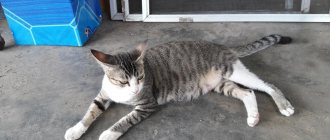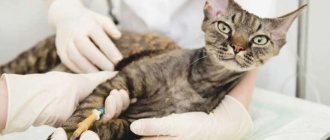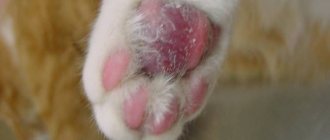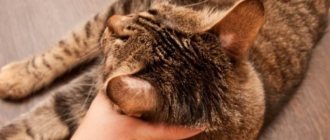Home / Cat breed / photo of flea bites on a cat
A cat in a house is the favorite of all residents, bringing comfort and warmth to it. In return, owners take care of the pet’s health and appearance. The main problem that all owners face is the appearance of fleas in cats, which often bother them with their bites.
Fleas in cats are parasites that are most often found in the summer in animals that go outside. Their appearance in the fur requires an immediate reaction from the owner aimed at destruction. Such parasites are carriers of various diseases and pose a threat not only to cats, but also dangerous to humans, because they can also bite people.
If insects multiply heavily in your pet's fur, diseases such as anemia, weakened general immunity, and others are possible. As a result, every owner should know what fleas look like on cats, where they come from and the signs of parasites in a pet, and then think about how to get rid of them.
Ways of parasites appearing in domestic animals:
In modern cities there are a large number of homeless animals, and the presence of unsanitary conditions contributes to the reproduction and comfortable existence of various types of parasites that migrate and infect domestic animals.
Fleas often carry worm eggs, so after eliminating ectoparasites from a pet, it should be additionally treated with anthelmintic drugs.
Symptoms indicating the presence of fleas in a cat:
- the animal behaves restlessly, actively itches, tries to bite off parasites and licks itself;
- some cats become nervous due to constant itching;
- Living adult insects can be found among the undercoat;
- red dots appear on the skin at the sites of bites; if an infection occurs, they become inflamed and can develop into wounds, possibly causing dematitis;
- black dots are visible among the fur - flea excrement;
- Pests can be found in places where a cat cannot reach them: near the ears, in the armpits, on the back, chest and neck.
If you suspect that cats have fleas, you should carefully examine the fur for the presence of black spots of digested blood. Flea feces, when rubbed with your fingers, are separated into small particles that are clearly visible among the hairs. If the undercoat is short, the animal combs it onto the floor, where it can become food for the larvae.
Flea reproduction
A female flea can lay up to 10 eggs per day, which she shoots in her fur onto the skin without attaching them to anything. They are very small, about 0.5 mm, white, visually similar to semolina groats. You can see what flea eggs look like in cats in the photo below.
The eggs easily slide off the fur, onto the floor or into the grass outside when walking. The flea larvae in cats that hatch after 14 days look like small dark worms that lack legs and eyes. The size of the larvae can reach 6 mm with a thickness of about 1 mm. They feed on organic waste or blood particles from flea feces.
Habitats for flea larvae: dust on the floor, carpets and furniture, various fleecy fabrics, ceiling cracks. Therefore, regular cleaning of the house with a vacuum cleaner will help greatly reduce the number of larvae and fleas in the apartment.
After a certain time, the larva pupates, and an adult insect emerges from the pupa and begins to look for its future owner.
The lifespan of a flea is 1.5 years, and during this time the female manages to lay up to 500 eggs. It's scary to even think how many fleas a pet can have if it is not treated. Cat fleas can also migrate to rats, displacing their own parasites.
Signs of fleas
First of all, you need to understand that a cat generally has fleas. The following symptoms raise suspicion:
- the cat itches, gnawing its fur;
- the animal is nervous;
- The cat appears unkempt.
In order to ensure the presence of fleas, the pet must be carefully examined. If there are spots, scratches, wounds, scabs on the skin, and black spots on the fur, then most likely these are fleas.
Black dots on an animal's fur are a sign of fleas.
One of our articles describes in detail methods for detecting and eliminating fleas on cats, which we recommend that you familiarize yourself with.
Diseases transmitted by blood-sucking insects
Fleas bite people only out of hunger, when their main host is absent. Single bites also occur when the apartment is highly infested with parasites.
What is dangerous about fleas living on cats is that they can transmit helminths that settle inside the fleas while they are looking for a new host. There are also microorganisms that fleas transmit:
- mycoplasmosis, which affects the body, causing purulent inflammatory processes;
- rickettsiosis - causes fever.
A bite can transmit bacillary angiomatosis to a person, infection of which is impossible without insects. However, it must be taken into account that other types of pests that transmit other types of diseases can also parasitize cats’ fur.
Among the flea family, rat species are especially dangerous because... they are capable of carrying infectious diseases: typhus, plague, etc. In the Middle Ages, half the population of cities and countries died as a result of epidemics of diseases transmitted by rats.
Treatment for ectoparasites
Veterinary clinics and pharmacies offer a wide range of medications against fleas on cats. All of them contain insecticidal components.
- Flea drops, which are applied to the cat's withers, are the most affordable, effective and widely used method, helping to rid the pet of parasite bites for a long time for a period of 1-2 months, they are safe for the animal, because drip onto areas of the body where the cat cannot reach with its tongue. They cannot be used for sick and pregnant women and kittens under 2.5 months of age. There are also drops against fleas and worms, which allow you to immediately destroy internal and external parasites. The most popular products of this form of release: Bars, Inspector, Lawyer, Celandine.
- Shampoos containing an active ingredient against parasites help get rid of fleas, but are only suitable for cats who like to bathe.
- Sprays are used less frequently because they require careful handling and compliance with protective measures in the form of a mask for humans and a collar for animals, they kill parasites within 2 days, and are not used for pregnant or lactating cats and kittens. Popular are Blokhnet and Bars.
- Flea powders for cats are rubbed into the animal’s skin, then the excess is carefully combed out.
- Tablets and injections for fleas can quickly solve problems with ectoparasites, but are not used for sick and pregnant cats.
- Collars are preventive measures aimed at repelling insects while walking down the street.
We recommend reading: DIY Cat Stand
When choosing an anti-flea product, you need to pay attention to its components. Thus, the substances permethrin, amitraz and organophosphates are not recommended for the treatment of pets, since they often cause allergies and other negative consequences. It is prohibited to use several insecticides at the same time, which can cause poisoning of the animal.
It is imperative to boil or treat the animal’s bedding or buy a new one, thoroughly wash the toilet and the pet’s favorite pastime places.
To get rid of fleas in an apartment, treatment is carried out using special powders, aerosols or insecticidal solutions. This helps to avoid re-infection of the animal, because flea larvae and eggs live on the floor and surrounding furniture.
To prevent the appearance of ectoparasites in pets, you should take preventive measures, monitor the condition of the skin and coat, and pay attention to their behavior. It is much easier to prevent the appearance of jumping “bloodsuckers” than to then remove fleas from a cat, spending considerable effort and financial resources to destroy the multiplied parasites.
Ectoparasite bites cause a lot of unpleasant and painful sensations, which often affects the health of an adult cat and, especially, a small kitten. Signs of flea bites on a cat are red, inflamed dots on the skin.
A cat can get fleas even if it never leaves its home. If a cat has parasites, all the inhabitants of the living space in which he lives are at risk. Contrary to erroneous belief, these tiny creatures parasitize not only felines, but also dogs, and also bite people. How to recognize a flea-infested pet? How to eradicate these parasites and make sure they don’t appear again?
Flea allergy treatment regimens
Before treating a cat's flea allergy, the resident first gets rid of the main cause of the disease - fleas. Then he treats his home, personal cat belongings, and also his garden plot with special insecticides if the pet lives in a private house.
Thus, they first sanitize their living space and area using highly effective insecticidal agents, and then begin to treat their sick cat.
Destruction of parasites
After completely removing fleas from their home, the household member will completely rid their cat of allergies within 2 weeks.
In such a situation, he performs the following actions:
- kills fleas on an infected pet;
- protects the cat from re-infection with mature small pests;
- removes the egg reservoir and flea larvae from your private household or apartment.
It should be borne in mind that if cats develop an allergy from fleas, pets should not be washed with shampoo or put on a flea collar.
There are 3 reasons for this:
- Washing is stressful for a cat;
- washing is a harmful and unpleasant procedure for an infected pet due to the formation of skin wounds;
- The collar is an effective preventive anti-flea agent. It does not rid the animal of these parasites and is contraindicated for skin ailments.
When using an anti-flea product, a household member gives it to the cat orally or drips it onto the cat's withers.
In such a situation, he performs the following actions:
- treats a sick animal with Comfortis tablets once every 1 month;
- drops such drops on the cat's withers - Advantage, Stronghold, etc. This needs to be done only 3 times (on the first day - 1 time, then after 14 days - 2 times, and then after 1 month - 3 times);
- Any anti-flea products are selected based on the cat’s body weight.
Sanitizing your home is considered a very important matter, because 90% of the flea population are small insect larvae and eggs. However, residents often underestimate the high efficiency of wet room cleaning of house dust and the use of a vacuum cleaner in their apartment.
During this type of cleaning, people remove most flea eggs.
In such a situation, a household member performs the following actions::
- daily vacuums places where the cat often rests, as well as various dark corners (under curtains, furniture);
- washes floors with cheap domestic products - Butox, Neostomazan, etc.;
- if the apartment has parquet or boards, then in this case the tenant uses a variety of insecticidal sprays (Raptor, Combat, etc.). The spray is also used to spray the space behind the room baseboards and places closed from prying eyes under the sofa, bed, cabinets and other furniture;
- washes blankets, carpets and cat beds in a washing machine on a specific automatic mode with high temperature.
Such events are carried out in places where cats are more likely to be (for example, in a car). However, even if the above conditions are met, only after 2-3 months do fleas leave the apartment or private house forever.
Symptomatic therapy for the formation of flea allergies
Also, if a cat develops an allergy from flea bites, the resident uses the following hormonal agents::
- Dexaforte (dose 0.05 ml/kg). It is given once orally to aggressive pets or cats that walk on their own;
- Prednisolone (dose 0.5-1 mg/kg). These tablets are given to animals for oral administration.
However, the antihistamines listed below do not help cats against flea allergies.:
- Suprastin;
- Tavegil;
- Zyrtek et al.
Antibiotics for flea allergies
If, during flea cat dermatitis, a reaction to flea bites such as purulent wounds or pyoderma appears on the animal’s skin, then in this case the household member treats it with various antibiotics.
In such a situation, the veterinarian prescribes specific antibiotics with a broad spectrum of action for the pet for a period of 2 weeks. Thus, if a cat has an allergic reaction to flea saliva, the owner treats it, for example, with an anti-flea agent such as Sinulox.
Cat skin restoration
In order to reduce inflammation on the cat’s skin and speed up its healing, the owner adds specific fatty acids to the pet’s food.
Also, if fleas often bite cats for a long time, then the pet owner buys such dry cat food:
- Coat Formula and Royal Canin Skin;
- Hill's z/d;
- Derma ProPlan Plus and others.
However, if a cat eats homemade food rather than store-bought food, then its owner adds the following nutritional supplements to the cat food:
- Medizinal Dorschlebertranl - fish oil from cod liver;
- Nordic Omega-3 Naturals - for cats and puppies.
Also, flea drops on the withers such as Allerderm and Essential-6 quickly heal inflamed areas of cat skin.
How can you tell if your cat is infected with fleas?
You can tell that a cat has these bloodsuckers by the following signs:
- Behavior change. An animal that has picked up fleas becomes restless, meows often, refuses to eat, and sleeps poorly. Due to complete or partial loss of appetite, the cat loses weight.
- Very severe itching caused by flea bites. To calm it down at least a little, the pet constantly itches and tries to gnaw pests out of its fur.
- The appearance of bloody wounds on the skin, which are caused by scratching. Over time, wounds can become inflamed and fester.
- Deterioration of the coat condition. Bald patches may appear on affected areas of the cat's body, revealing inflamed, red skin.
The listed symptoms are similar to those caused by other parasitic insects. Before starting treatment, you need to make sure that your pet has fleas. To check this, you need to carefully examine the cat's fur, parting it with a comb or blowing it. The presence of bloodsuckers is indicated by the presence of black adult parasites and white grains (eggs), as well as flea excrement in the form of dark pieces of dirt.
When traces of parasites cannot be detected in this way, you should comb the cat’s fur and shake the comb over a sheet of white paper. On a light background, the remains of fleas will be clearly visible.
Knowing why your pet gets fleas can help prevent this problem from occurring. It is impossible to say exactly where the cat got these parasites from. There are several ways to infect pets that roam freely on the street and are never outside the apartment:
- Contact with infected animals while walking. A cat can pick up fleas not only from its relatives, but also from dogs.
- Mating with an infected partner.
- Using items from an infected animal to care for a pet.
- Cutting and combing with untreated tools that were previously used to cut and comb an infected animal.
- Through the street shoes of the inhabitants of the home.
- Hunting for flea-ridden rodents.
- Infection of newborn kittens from the mother.
- Infection by parasites that have moved into the apartment from neighbors or from the entrance.
- During contact with birds flying to an unglazed balcony to which the cat has free access.
Prevention
To prevent allergic reactions to ectoparasites, your pet should not be allowed outside. You will need to limit contact with street dogs and cats. Once every 6 months it is important to prevent helminthic infestation and fleas. It is recommended to wear a collar on your cat to protect against parasite bites. You should resort to his help even in a situation where your pet does not go outside. In addition, it is better to take off your shoes outside the house. If this is not possible, upon returning from the street you should immediately wash the soles of your shoes.
What and how to treat a cat bed and other objects?
To remove fleas, it is not enough to treat the animal, since parasites live not only on the owner, but in his bed and toys, as well as in other places in the house. To destroy all bloodsuckers, it is necessary to carry out a thorough disinfestation of the room in which the pet who has recovered from entomosis lives. You can do this in the following ways:
- Wash your cat's bedding and toys in very hot water. It is recommended to use insecticidal shampoo for washing.
- Wash the floor and wipe other horizontal surfaces in rooms where the flea-bearing cat has been with an insecticidal agent. Sprays and powders can also be used for treatment.
Animals should be treated with sprays and aerosols taking into account the following recommendations:
The cat flea in the photo and in reality looks like a plant grain - small, smooth, shiny brown, red or black. The body length is 2–3 mm. All types of fleas look the same to the average person. Only under a close-up microscope can one see that fleas differ from each other in the structure of their heads and the number of bristles on their legs. The laterally flattened body ensures easy movement of the parasite within the host’s hairline. The flea does not have wings, but has long hind legs, with which it can make jumps 20–30 cm long.
We recommend reading: Kitten Constantly Vomiting
You can distinguish a flea from a louse by its color - the body of the latter is painted in a lighter shade. In this case, the louse crawls, rather than jumps, and is usually found on the cat’s fur, and not on the skin.
The flea reproduction process takes from 20 minutes to 3 hours. One individual lays about 10 eggs per day. More precisely, it does not lay, but shoots from the abdomen, which ensures that the eggs reach a long distance. As a result, they are placed not only on the cat's body, but also on other animals and in the environment. The size of a flea egg is 0.5–1 mm, it looks like a small grain of rice, white and translucent (see photo). The larvae look like dark-colored worms, the body length of which is 6 mm, thickness – 1–2 mm. They can live in upholstered furniture, carpets, and cracks.
The life cycle of a flea consists of several stages. The egg hatches into a larva after a few days, then it turns into a pupa, which eventually becomes a flea. The larvae feed on organic waste or excrement of adult fleas containing blood residues.
Comfortable temperature for insect life is 37°C. When it increases, the flea's lifespan is shortened and the eggs mature faster.
Features of therapy
Allergies in cats must be treated.
- First of all, fleas are removed not only from the cat, but also from the house. In the future, it is necessary to ensure that fleas do not appear, since even one bite is enough for the animal to get sick again.
- At the first sign of an allergy, the cat should be given an antihistamine. This group of drugs includes suprastin and diphenhydramine. The dosage of the drug for the cat will be prescribed by the doctor. If there are indications, then hormonal drugs such as perdnisolone, dexafort can be prescribed.
- Itchy skin in cats must be relieved. For this, hydrocortisone ointment is used. But it cannot be used if the cat has already scratched the bite sites and wounds and suppuration have appeared.
- You can try to heal any sores and scratches that appear with chloramphenicol ointment. It is important to prevent further inflammation.
- Creams containing aluminum relieve itching and heal well. These include “Alusprey”, “Aluminium”.
"Alusprey" effectively relieves itching and heals scratched wounds in cats
- When treating a cat, it is necessary to deprive it of the opportunity to lick the medicine off itself. Otherwise, this will only lead to a worsening of her condition and to poisoning. You can hold your pet in your arms until the drug is absorbed, but this is inconvenient and time-consuming. It is easier to put a special tube collar on the cat, which will prevent it from licking itself.
- In difficult cases, a course of injections with hormonal corticosteroids is indicated. Injections very quickly alleviate the animal’s condition and stop attacks for a long time.
- The most modern and effective method is immunotherapy. In this case, cats are injected with flea saliva extract in extremely small quantities. The administration of the extract has been practiced for a long time. This method helps to improve the functioning of the immune system and help it stop reacting so inadequately to the allergen. In 50% of cases in cats after immunotherapy, allergic reactions either become extremely minor or disappear completely.
How to rid an animal of fleas?
You can rid your cat of fleas at home. There are remedies for bloodsuckers in the form of shampoo, collar, drops, sprays, tablets, injections. Which ones should you choose? To quickly and effectively eliminate parasites, an integrated approach is required. Not only the animal itself will have to be processed, but also its belongings, as well as all the places where it lives.
Insecticidal preparations for kittens and adult cats
Flea treatments containing insecticides are effective. If the cat is not afraid of water, it is worth starting treatment with bathing and using a special shampoo or tar soap. You should lather your pet and do not rinse off the detergent for 10 minutes. After this, rinse the cat well, wrap it in a towel and dry it. The use of a hairdryer is encouraged, because fleas do not like high temperatures.
You can also use a spray or drops. During processing, you must wear gloves and a protective mask. If a spray is chosen as an insecticide, the animal should be wearing a collar to prevent it from licking off toxic substances. The drops should be applied to the animal's withers; a special collar is not required, since the treated area is inaccessible to the pet. Drops and sprays are contraindicated for kittens under 2.5 months of age, pregnant and sick cats. There are also drops that destroy fleas and worms (Leopard, Inspector, Lawyer, Celandine).
Another method of getting rid of fleas on a cat’s body is a special powder. It is applied to the animal's skin, spreading the fur, and then combed out. The most popular powders are Flicar, Celandine, Insectin.
Tablets and injections can quickly get rid of parasites, but they are best used as prescribed by a veterinarian. It is necessary to pay attention to the composition of the drug. Components such as permethrin, amitraz, and organophosphates can cause intoxication and poisoning. It is recommended to give preference to products based on selamectin, finpronil, imidacloprid. The following drops are suitable for pregnant and lactating cats, as well as kittens over 2 months of age:
- Advantage;
- Frontline Combo;
- Beafar.
These categories of pets are recommended to bathe with anti-flea shampoo, tar soap, infusion of wormwood, chamomile or tansy. Newborn kittens infected with fleas will have to be combed out. For this, a special comb with fine teeth is used. The procedure must be carried out over a container of water so that the insects fall into it.
Treatment of beds and apartments
To completely remove bloodsuckers, it is necessary to treat not only the pet’s fur, but also its habitat. For this purpose, you can use aerosols, powders, and liquids. Aerosols effectively eliminate adult insects, but do not affect larvae and eggs. However, treatment in this way requires careful preparation, since the aerosol easily enters the respiratory tract of humans and animals and can cause intoxication.
Powdered products act for a long time and have a detrimental effect on the larvae. They are scattered in possible places where parasites accumulate - in cracks, under furniture, behind baseboards, in the corners of rooms, near a trash can. The most effective flea powders: Fas Double, Tornado, Phenaxin, Clean House.
The safest flea remedy for households is Pyrethrum. It is recommended to use it if small children live in the apartment. The powder is based on Dalmatian chamomile inflorescences. When an insect comes into contact with an insecticide, the functioning of the nervous system is disrupted, resulting in the death of the flea. Directions for use: 6 tbsp. l. The products are diluted in 1 liter of water and the apartment is treated with a spray bottle.
What to do with carpets, cat beds and other textiles? Carpets should be vacuumed, then beaten and treated with insecticide. The vacuum cleaner should also be treated after the procedure - wash the bag with anti-flea agent, and wipe the body with a liquid solution. Cat clothes must be washed in hot water, after soaking them with insecticide for several hours. For this purpose, you should choose a product that effectively eliminates not only adult insects, but also larvae and eggs.
We recommend reading: Fusion of vertebrae in a cat
Treatment methods
There are a large number of methods and drugs to kill parasites. There are no universal ones among them: the choice depends on the cat’s health condition and the specific situation.
Anti-flea products
The same means are not always suitable for prevention and treatment. The question of the intended purpose of the drug must be resolved before going to the store. When choosing a medicine, consider the age of the animal and the number of parasites on its body. If there are many of them, then an integrated approach will be required .
| Means | Description | Examples |
| Pills | Contains luferon, a substance that is lethal to fleas. They receive it along with the blood and die. | "Comfortis", "Bravecto", "Frontline" |
| Drops | Apply to the withers or along the cat's spine for treatment or prevention. A very effective drug. | "Stronghold", "Hartz", "Advantage" |
| Sprays | Necessary only in case of severe infection, as they are toxic. Therefore, a collar is required: to prevent the medicine from entering the body. | "Hartz", "ABC Phytodoc", "Bars", "Frontline" |
| Shampoo | The safest remedy. It can even be used to treat kittens. Often used together with drops. | “Rolf Club”, “Bio Groom”, “Fitoelita”, “Biovax”, “Mr. Kiss" |
| Powders and powders | For the treatment of kittens and pregnant cats only. | "Zecken Und Flohpuder" |
| Collars | Used together with shampoo for prevention. Not suitable for pregnant or lactating cats. | “Clandestine”, “Hartz”, “Bayer”, “Bolfo” |
| Injections | Prophylactic. The effect lasts 6 months. They do it in veterinary clinics. | "Lufenuron", "Ivermek", "Eprimek" |
Important!
If there is a large number of lesions on the body, then products for external use cannot be used.
other methods
There are also traditional methods for ridding your pet of fleas. This treatment will be effective in case of minor infection. The following factors may also be reasons to abandon traditional medicine:
- pregnancy;
- allergies to insecticides;
- an animal disease for which the use of medications is incompatible.
| Means | Application |
| Sagebrush | The smell of wormwood repels all blood-sucking parasites. Her decoctions and tinctures are safe and therefore suitable for kittens. |
| Vinegar | The use of vinegar is permissible only in extreme cases and is suitable only for the most patient pets. The cat is treated with a mixture of vinegar, ammonia and cologne, kept in cellophane for 10 minutes (the head is not covered), washed, dried, and combed. |
| Garlic | Garlic tincture is used to wipe the cat's fur in places inaccessible to it. Or, when used on the entire body, wear an anti-lick collar. |
| Salt | A saturated saline solution is added to the bathing water. The animal is washed for 5-7 minutes, after which it is rinsed with clean water. |
| Geranium | You can also bathe your pet in a chilled decoction of geranium and lavender. |
| Essential oils | For 3 glasses of water - 3 drops of cedar, rosemary, lavender, mint or geranium oil. The product is suitable for spraying, applying to a collar or adding to shampoos. |
Important!
Do not use used machine oil for treatment. This increases the content of heavy toxins in the animal's blood.
Home processing
Fleas are not permanently present on the host's body. They can hide in upholstered furniture or carpets. Therefore, for treatment to be successful, it is necessary to eliminate parasites from the tailed friend’s habitat.
- Carpets should be vacuumed, beaten outside, and treated with an anti-flea solution.
- Textiles, soft toys and clothes will have to be soaked in an anti-flea solution and then washed.
- Vacuum the furniture and treat it thoroughly. The upholstery of upholstered furniture can be disinfected with a steam generator.
- Do wet cleaning.
- Carry out chemical treatment of surfaces.
Pay special attention to the cat's bedding, toys and house. If possible, replace them. Don't forget to treat other pets.
Processing agents
Preparations for treating premises must meet certain criteria :
- be safe for all inhabitants of the house;
- be easy to use;
- act quickly;
- contain several active substances belonging to different groups of insecticides.
They are sold in the form of various aerosols, powders or concentrates for preparing a solution. Most Popular:
- aerosols - “Raptor”, “Dichlorvos”, “Raid”;
- powders - “Peretrum”, “Brownie”, “Clean House”;
- con, "Biorin", "Get".
Important!
Wear a respirator when using these products.
What happens if you don't kill fleas on a cat?
If you do not remove fleas from your cat in time, the consequences for it can be disastrous. Constant itching disrupts the cat's emotional state, which leads to sleep problems, loss of appetite, and mental disorders. Scratching wounds leads to secondary infection, development of dermatitis, formation of pustules and ulcers. Allergy to bites manifests itself in the form of swelling of the affected area. The fur begins to fall out, the cat looks unkempt and sickly. In addition, a pet can become infected with an infectious disease or worms through a flea.
Bloodsuckers pose a particular danger to kittens. A fragile body is not able to cope with a disease that can be contracted from a flea, as well as with severe allergies. Parasites reproduce quickly, and the lifespan of one insect is 1.5 years. If measures are not taken to eliminate fleas immediately, the baby will soon be swarming with bloodsuckers. Kittens often develop anemia due to insect parasitism, which often leads to death.
- Advantage;
- Frontline Combo;
- Beafar.
Symptoms of the disease
An allergy to flea bites in cats is confirmed by a clinical examination of the animal, as a result of which the parasites themselves or, most often, traces of their vital activity can be found on the pet’s body.
Fleas do not live on animals permanently. They get enough blood and jump off the animal to lay eggs, hiding in secluded places.
In the vast majority of cases, fleas live on the cat's bedding, under sofas or carpets, on which the animal often rests. That is why, if flea dermatitis is detected in a pet, caused by an allergic reaction to parasite bites, it is necessary to treat animal care items, ammunition and sleeping places with special products.
An allergy to flea saliva develops individually in each animal, but the clinical picture in most cases has the following characteristics:
- the occurrence of severe itching (the pet tries to scratch hard-to-reach places, sometimes biting itself with its teeth);
- areas of alopecia - when the upper layer of the dermis is damaged due to developing inflammation, the hair follicles suffer, so the hair in the affected areas begins to fall out;
- formation of tubercles - papules appear at the site of the flea bite, characterized by further development of inflammation and itching;
- change in pigmentation of the skin and coat;
- skin hyperemia and severe swelling at the site of the bite.
Some animals that are hypersensitive to the allergen may exhibit signs of flea dermatitis, such as a dry cough, frequent sneezing, and clear discharge from the eye area and sinuses.
The pet is also noted to be depressed or, on the contrary, increased excitability. The animal may show unmotivated aggression, especially when the owner tries to touch the affected areas of the skin.
Severe itching leads to scratching, which is characterized by injury to the skin. Often in veterinary practice, flea allergy is complicated by a bacterial infection. Pathogenic microflora easily penetrates into the deep layers of the epidermis through small wounds and cracks.
Timely treatment and preventative measures for flea dermatitis will allow the owner to protect their pet from possible complications. It is no secret that fleas are carriers of dangerous diseases, the most common of which are helminthiasis. In addition, if there is a strong flea infestation, the animal may die from anemia.
In some cases, a cat becomes allergic to a flea collar, manifesting itself with symptoms similar to those of flea dermatitis. The body reacts not only to the chemical insecticide with which the flea collar is impregnated, but also to natural essential oils. They are not as toxic as chemicals, but can provoke not only the development of a pathological reaction on the pet’s skin, but also cause respiratory diseases.
An anti-flea collar can cause not only watery eyes and redness on the skin, but also provoke much more serious complications, manifested in the form of convulsions, eruption of gastric contents, diarrhea, and loss of consciousness.
Find out more about other types of allergies in cats>>>
External signs
The symptoms look similar to other bites. These are small reddish swellings. The puncture is not visible due to the elasticity of the skin. But the person is clearly irritated. After walking in the forest, bites are often confused with wounds from “hooks” in bushes.
The flea leaves a series of bites, the distance between which reaches a centimeter
Symptoms from a puncture of the dermis by a cat flea are not clearly expressed. Often they completely disappear after 2 days, and stop itching after an hour.
The most striking symptoms:
- sharp and sharp pain at the time of the bite, almost like from a syringe;
- severe itching, stronger than a mosquito bite;
- a characteristic feature on human skin is a series of bites, the distance between which reaches a centimeter;
- As a rule, fleas bite a person’s legs up to the knee, but if people are sleeping, the parasites can reach the armpits.
Ground fleas bite in the same way as bedbugs. This is why many people, when they see swelling, decide that they have been visited by a bug. But that's not true. Bed bugs leave trails, but fleas only leave a couple of bites.
What is an allergy
An allergy is an abnormal response of the immune system to foreign substances, including enzymes and proteins, entering the body. These proteins act as allergens that provoke an immune response in individuals.
It must be said that not all cats develop an allergy to fleas. Most cats tolerate flea bites calmly, without showing any reactions. Moreover, they do not even have particularly severe skin damage, since the itching and pain from the bite go away quickly and the cat does not have time to seriously injure its skin.
Our readers recommend! To get rid of allergies, our readers recommend Allegard. It restores metabolic processes, removes allergens and toxins from the body, and also relieves 3 main symptoms: itching, swelling, lacrimation.
Read more here...
But some cats have a special sensitivity to the enzymes that the flea injects under the skin at the time of the bite. And they develop allergies.
Other symptoms
Earth fleas and other types of fleas bite humans in different ways.
Flea bites look different for each person
- Cat parasites leave a small rash on people's skin. It's similar to a plant allergy.
- A human being bitten by an elk flea will leave a significant lump, similar to a bee infestation.
- Most often, people are bitten by human parasites. They leave a redness the size of a cigarette burn.
- If earthen or other insects inflict several bites, people experience a generalized reaction. Doctors treat it as a skin disease.
What to do
At the first suspicion of an allergy, you should go to a veterinarian and check your cat for the presence of antibodies in the blood. To do this, the cat's blood is taken and an IgE test is performed. Or a skin test is done where flea enzyme is applied to the skin. The reaction determines whether the animal is allergic to fleas or whether the itching is due to other reasons.
At the first suspicion of an allergy, you need to go to a veterinarian and check the cat for the presence of antibodies in the blood
Consequences of bites
When fleas bite people, they experience severe pain. The consequences for humans can be different, it all depends on the toxicity of the enzymes entering the skin.
After being bitten by sand fleas and other types of fleas, bleeding may occur under the dermis. As a result, hemorrhage occurs. If there is a significant concentration of bites on one area of the body, purpura will occur.
In case of serious consequences, you should consult a doctor
For people, skin lesions can result in:
- serious, difficult to diagnose disease;
- allergy to an enzyme, which can affect blood clotting and in some cases cause swelling or anaphylactic shock;
- an infection caused by scratching a bite.
A person develops an allergy if he previously had a predisposition to it. Children under 12 years of age are most susceptible to it. Infections pose a greater threat.
Allergy symptoms and how to recognize them
So what symptoms can you use to distinguish your pet’s allergies from other diseases? There are a number of characteristic signs of allergies. But there is also a problem that it is impossible to determine from them what caused this condition.
To solve this problem, you need to contact a veterinary hospital, where specialists can conduct laboratory tests to determine the cause of this reaction. But what symptoms, after all, are determining in making a diagnosis of allergy?
At first it can be local, and then spread to large areas of the body. The rash can develop into allergic dermatitis, which indicates the addition of a bacterial infection.
The next symptom is itching. Cats itch mainly in the area of the root of the tail, back and ears. Itching is a consequence of the release of biologically active substances in response to an allergen that has entered the body. Constant itching can lead to damage to the skin and secondary infection.
Skin redness
Redness of the skin in the ear area and the ears themselves is also one of the symptoms of allergies.
The animal may try to scratch them, which can lead to skin lesions and otogemetomas - accumulations of blood under the skin of the auricle. Constant itching and inflammation of the skin can lead to bald patches on the skin and severe hair loss, which can also indicate an allergy in your pet.
In very furry animals, it is difficult to notice such a symptom as redness of the skin. On the contrary, in hairless cats, such as Sphynxes and Bambinos, these manifestations are always very noticeable, and these breeds themselves are highly allergic. Some time after the appearance of redness, peeling skin and dandruff may occur.
And it is also worth paying attention to discharge from the eyes and nose, which may be another indication of problems in the animal
Diarrhea, vomiting, snoring
Diarrhea and vomiting are common and characteristic signs of allergic reactions of a food nature. Snoring can also indicate an allergy. This phenomenon is explained by swelling of the nasal mucosa and difficulty in the passage of air through the nose during sleep.
Although these are not all the signs of allergies in cats, if you notice even one of them, you should immediately consult a veterinarian, without waiting for all of them to appear.
Flea under a microscope (video)
Cat flea bite
Cat fleas also bite people. At the same time, parasites can carry many dangerous diseases, including fungal infections and plague. This type of insect also carries eggs:
- flat 50 cm worms;
- cucumber tapeworms;
- other helminths.
When bitten, eggs enter the human bloodstream and spread throughout the body. Allergic inflammation can occur in any organ.
Rat flea bites
Rat fleas bite with serious consequences. They can carry typhoid, plague and other terrible diseases. 200 agents of various diseases have been identified. It is impossible to know for sure how the bite will turn out. Microbes in the body of the parasite remain for up to a year.
If rat fleas bite, you should not scratch the lesion: there is a danger of introducing an infection into the wound. The thing is that insect excrement may remain on the skin, and a person can accidentally introduce it into the body. It is important to properly treat the wound to alleviate the itching. If pus accumulates in the swelling, it is less tolerable than the initial pain.
Rat fleas can carry typhus, plague and other terrible diseases











